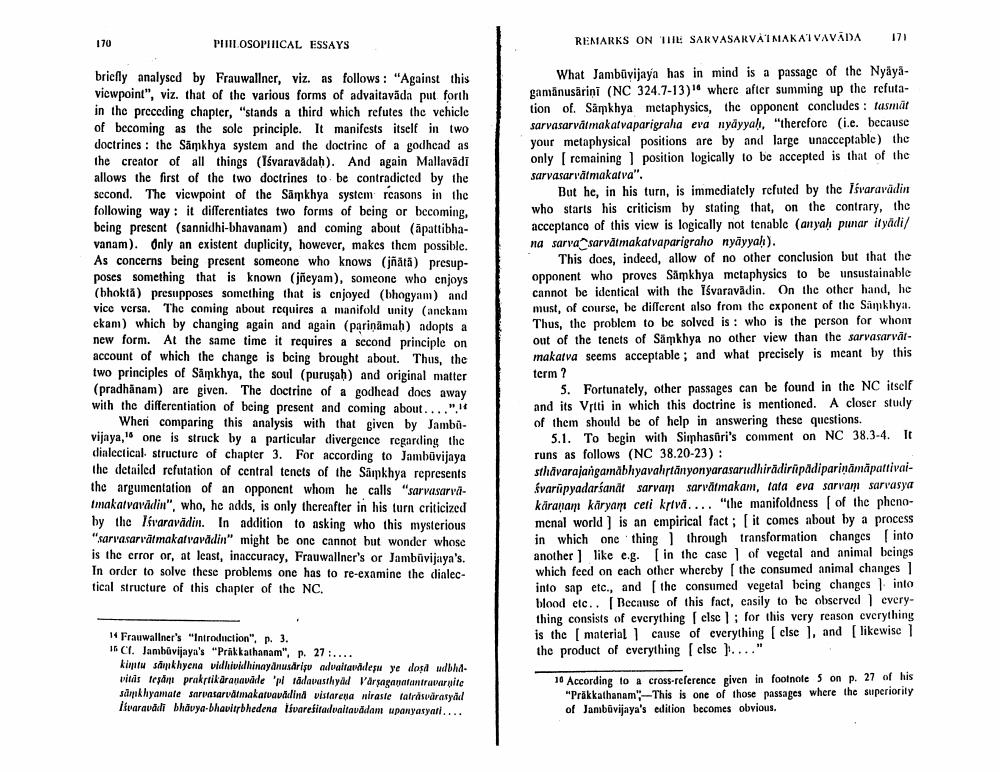Book Title: Remarks On Sarvasarvatmakatvavada Author(s): A Wezler Publisher: A Wezler View full book textPage 3
________________ 170 PIILOSOPHICAL ESSAYS REMARKS ON TIRE SARVASARVAIMAKATVAVADA 171 briclly analysed by Frauwallner, viz. as follows: "Against this viewpoint", viz. that of the various forms of advaitavada put forth in the preceding chapter, "stands a third which refutes the vehicle of becoming as the sole principle. It manifests itself in two doctrines: the Samkhya system and the doctrine of a godhcad as the creator of all things (Išvaravādah). And again Mallavadi allows the first of the two doctrines to be contradicted by the second. The viewpoint of the Sankhya system reasons in the following way: it differentiates two forms of being or becoming. being present (sannidhi-bhavanam) and coming about (apattibhavanam). Only an existent duplicity, however, makes them possible. As concerns being present someone who knows (at) presupposes something that is known (jñeyam), someone who enjoys (bhokta) presupposes something that is cnjoyed (bhogyam) and vice versa. The coming about requires a manifold unity (anckam ekam) which by changing again and again (parinamah) adopts a new form. At the same time it requires a second principle on account of which the change is being brought about. Thus, the two principles of Samkhya, the soul (puruşah) and original matter (pradhanam) are given. The doctrine of a godhead does away with the differentiation of being present and coming about....." When comparing this analysis with that given by Jambuvijaya," one is struck by a particular divergence regarding the dialectical structure of chapter 3. For according to Jambūvijaya the detailed refutation of central tencts of the Sankhya represents the argumentation of an opponent whom he calls "sarwasarvaImakarvavadint", who, he adds, is only thereafter in his turn criticized by the lśvaravādin. In addition to asking who this mysterious "sarvasarvatmakarvavadin" might be one cannot but wonder whose is the error or, at least, inaccuracy, Frauwallner's or Jambivijaya's. In order to solve these problems one has to re-examine the dialectical structure of this chapter of the NC. What Jambivijaya has in mind is a passage of the Nyaya - gamanusarini (NC 324.7-13) "" where after summing up the refutation of Samkhya metaphysics, the opponent concludes: tasmat sarvasarvatmakarvaparigraha eva nyáyyah, "therefore (i.c. because your metaphysical positions are by and large unacceptable) the only remaining position logically to be accepted is that of the sarvasarvatmakalva". But he, in his turn, is immediately refuted by the Isvaravädin who starts his criticism by stating that, on the contrary, the acceptance of this vicw is logically not enablc (anyah punariyadi/ na sarvasarvatmakarvaparigraho nyayyah). This docs, indeed, allow of no other conclusion but that the opponent who proves Samkhya mctaphysics to be unsustainable cannot be identical with the iśvaravādin. On the other hand, he must, of course, be different also from the cxponent of the Sankhya. Thus, the problem to be solved is: who is the person for whom out of the tenets of Sankhya no other view than the sarvasarvatmakarva seems acceptable; and what precisely is meant by this term ? 5. Fortunately, other passages can be found in the NC itself and its Vriti in which this doctrine is mentioned. A closer study of them should be of help in answering these questions. 5.1. To begin with Sirphasüri's comment on NC 38.3-4. It runs as follows (NC 38.20-23): sthävarajangamabhyavahrtänyonyarasarudhiradiripadiparināmāpattivaisvariipyadarśanat sarvam sarvatmakam, tata eva sarvami sarvasya karanam karyam ceti kriva.... "the manifoldness of the phenomenal world ) is an empirical fact; it comes about by a process in which one thing through transformation changes into another like e.g. [in the case of vegetal and animal beings which feed on cach other whereby the consumed animal changes 1 into sap etc., and the consumed vegetal being changes into blood etc.. Because of this fact, casily to he observed everything consists of everything else 1: for this very reason everything is the material cause of everything else I. and (likewise the product of everything else )...." Frauwallner's "Introduction", p. 3. 16 Ch. Jambūvijaya's "Prākkathanam", p. 27:.... kiitu simkhyena vidhvilhinayusdrigu odvaitadilesi ye dosd wide vitit tepdm prakrikdramawide 'p tadawasthydd Varsaganafaniramite simhyamate sarvasarvatmakarvavadind vistarena wiraste fatrwdrarydel Ilvaravali bhavya-bhaviebhedena tivarejitadvaltavadami upanyayail.... Satanawiwite wind vistarena 10 According to a cross-reference given in footnote 5 on p. 27 of his "Prakkathanam This is one of those passages where the superiority of Jambūvijaya's edition becomes obvious. wadi bhavya-bhavitchhePage Navigation
1 2 3 4 5 6 7 8
